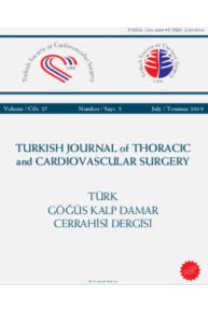Benign mediastinal lezyonlara robotik yaklaşım
Robotic approach to benign mediastinal lesions
___
- Melfi F, Fanucchi O, Davini F, Viti A, Lucchi M, Ambrogi MC, et al. Ten-year experience of mediastinal robotic surgery in a single referral centre. Eur J Cardiothorac Surg 2012;41:847-51.
- Cerfolio RJ, Bryant AS, Minnich DJ. Operative techniques in robotic thoracic surgery for inferior or posterior mediastinal pathology. J Thorac Cardiovasc Surg 2012;143:1138-43.
- Keijzers M, de Baets M, Hochstenbag M, Abdul-Hamid M, Zur Hausen A, van der Linden M, et al. Robotic thymectomy in patients with myasthenia gravis: neurological and surgical outcomes. Eur J Cardiothorac Surg 2015;48:40-5.
- Bayrak Y, Tanju S, Öztürk E, Dilege MŞ. Akciğer kanserinde robotik lobektomi: Erken dönem sonuçlar. Turk Gogus Kalp Dama 2014;22:785-9.
- Toker A, Özyurtkan MO, Kaba E, Ayalp K, Demirhan Ö, Uyumaz E. Robotic anatomic lung resections: the initial experience and description of learning in 102 cases. Surg Endosc 2015 Jun 20. [Epub ahead of print]
- Ismail M, Swierzy M, Rückert RI, Rückert JC. Robotic thymectomy for myasthenia gravis. Thorac Surg Clin 2014;24:189-95.
- Marulli G, Schiavon M, Perissinotto E, Bugana A, Di Chiara F, Rebusso A, et al. Surgical and neurologic outcomes after robotic thymectomy in 100 consecutive patients with myasthenia gravis. J Thorac Cardiovasc Surg 2013;145:730-5.
- Kumar A, Asaf BB. Robotic thoracic surgery: The state of the art. J Minim Access Surg 2015;11:60-7.
- Goldstein SD, Yang SC. Assessment of robotic thymectomy using the Myasthenia Gravis Foundation of America Guidelines. Ann Thorac Surg 2010;89:1080-5.
- Freeman RK, Ascioti AJ, Van Woerkom JM, Vyverberg A, Robison RJ. Long-term follow-up after robotic thymectomy for nonthymomatous myasthenia gravis. Ann Thorac Surg 2011;92:1018-22.
- Pandey R, Elakkumanan LB, Garg R, Jyoti B, Mukund C, Chandralekha, et al. Brachial plexus injury after robotic-assisted thoracoscopic thymectomy. J Cardiothorac Vasc Anesth 2009;23:584-6.
- Cerfolio RJ, Bryant AS, Minnich DJ. Starting a robotic program in general thoracic surgery: why, how, and lessons learned. Ann Thorac Surg 2011;91:1729-36.
- Mineo TC, Pompeo E, Ambrogi V. Video-assisted thoracoscopic thymectomy: from the right or from the left? J Thorac Cardiovasc Surg 1997;114:516-7.
- Schneiter D, Tomaszek S, Kestenholz P, Hillinger S, Opitz I, Inci I, et al. Minimally invasive resection of thymomas with the da Vinci® Surgical System. Eur J Cardiothorac Surg 2013;43:288-92.
- Ye B, Li W, Ge XX, Feng J, Ji CY, Cheng M, et al. Surgical treatment of early-stage thymomas: robot-assisted thoracoscopic surgery versus transsternal thymectomy. Surg Endosc 2014;28:122-6.
- Ye B, Tantai JC, Ge XX, Li W, Feng J, Cheng M, et al. Surgical techniques for early-stage thymoma: video-assisted thoracoscopic thymectomy versus transsternal thymectomy. J Thorac Cardiovasc Surg 2014;147:1599-603.
- ISSN: 1301-5680
- Yayın Aralığı: 4
- Başlangıç: 1991
- Yayıncı: Bayçınar Tıbbi Yayıncılık
Benign mediastinal lezyonlara robotik yaklaşım
Alper GÖZÜBÜYÜK, Sedat GÜRKÖK, Ersin SAPMAZ, Okan KARATAŞ
Adnan YALÇINKAYA, Seyhan YILMAZ, Taner SARAK, Volkan ÇAMKIRAN, Kerim ÇAĞLI, Adem İlkay DİKEN
Buket AKINCI, İpek YELDAN, Zehra BAYRAMOĞLU, Tahsin Belhhan AKPINAR
Emrah ŞİŞLİ, Yasemin TÜRKEKUL, Adnan YÜKSEK, C Tayyar SARIOĞLU, Arda SAYGILI, Yusuf Kenan YALÇINBAŞ
Pelin KARAASLAN, Cem ERDOĞAN, Arda ÖZYÜKSEL, Kamil DARÇIN, Banu GÖKAY VURAL
Ayten CANGIR KAYI, Cabir YÜKSEL, Serkan ENÖN, Hakan KUTLAY, Nezih ÖZDEMİR, Dalokay KILIÇ, Oya YILDIZ, Murat AKAL, İlker ÖKTEN, Şevket KAVUKÇU
Aortopathy following the correction of tetralogy of Fallot
Recep Oktay PEKER, Şafak ALPAT, Mustafa YILMAZ
Nida ÇELİK, Halil TÜRKOĞLU, Abdullah Arif YILMAZ, Türkay SARITAŞ, Ulaş KARADAŞ
Çocuk kalp ve damar cerrahisi mi, doğumsal kalp hastalıkları cerrahisi mi?
Emrah ŞİŞLİ, Münevver DERELİ, Yüksel ATAY, Mehmet Fatih AYIK
The evaluation of cases with double-inlet left ventricle-ventriculoarterial discordance
Alper GÜZELTAŞ, Öykü İsal TOSUN, Taner KASAR, Pelin AYYILDIZ, İhsan BAKIR, Yakup ERGÜL, Ender ÖDEMİŞ
